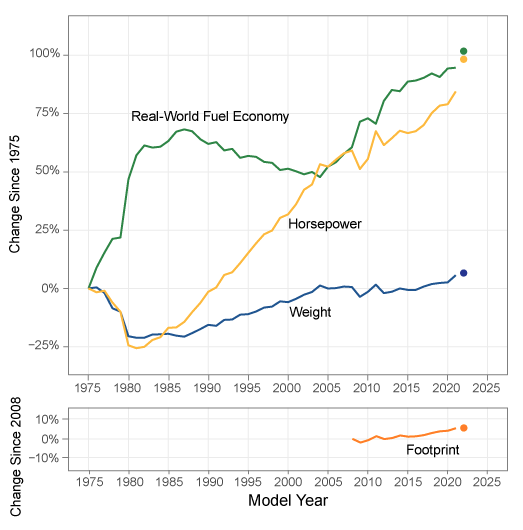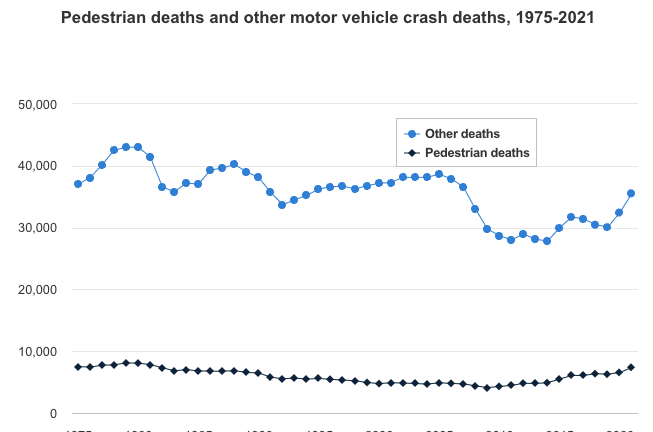Y'know how I like nuance and am skeptical of simple narratives?
Well, I have a bugbear regarding the discussion on pedestrian fatalities in the US.
To start this thread, I'd like to think I have an unbiased perspective here. I don't drive a very large vehicle, I loathe the arms race in vehicle size, and I welcome all efforts to reduce car-dependence and make our streets safer for all.
But... every discussion I listen to on this topic is real handwavey on the impacts of distracted driving.
The sudden reversal in reduction in pedestrian deaths coincides not only with increase in vehicle size, but the prevalence of the smartphone.
Anybody who drives and gives the remotest shit about being a safe driver will have noticed how many other folks are holding their phones and looking at them while driving 40+ miles per hour, and I really feel like this can't be dismissed as a factor. But seemingly nobody talks about this as meaningful.
@TechConnectify It feels like THE most-important factor. I know multiple people who were struck my careless drivers distracted with phone shenanigans.
I'd like to see someone suss out the data on the number of pedestrian collisions that are occurring over time, but I can't find it easily.
Deaths are obviously going up, and I'm not arguing that a larger car isn't more dangerous to pedestrians and other road users (they most certainly are).
But... I'm almost certain pedestrian impacts have gone up, making you more likely to be hit in the first place. That's important and that matters to the discussion.
That's what I really want to know.
Are people getting *hit* more often? I'm almost certain the answer is yes.
There are plenty of other things we're uniquely bad at, too - road design, licensing requirements, lack of regulations. So by no means am I saying that I feel smartphones are the primary issue here, and I also don't want to make this a personal responsibility thing.
But I'm really weirded out by how this one very much so personal responsibility aspect is just... completely ignored.
@TechConnectify isn’t that what everyone says, that smartphones are making for distracted drivers? I thought that was the whole point
@ezekiel listen to people who are (not by any means incorrectly) focused on safer street designs and they often just ignore this factor.
@scott I want to push back on the framing here: I'm saying there isn't any issue that can be identified as *the* issue.
I hold both that bigger vehicles are more dangerous and that people are getting more distracted in my head at the same time.
Another reason I'm hesitant to call vehicle size *the* issue is that truck and SUV sales have been exploding since the '90s, and the reversal in death trends is newer than that.
@TechConnectify Getting data on this topic is hard, even for a single locale (like say an EU country). Sometimes you'll get tables for the types of vehicles (or lack thereof) involved, sometimes you may even get charts on compounding factors (DUI, tiredness, distracted driving, etc).
But, if one assumes that European drivers are just as likely to be distracted as North American ones, the size of vehicles does pop out… as a correlation. At least, that's what I can tell at a cursory glance.
@remi right, but I think enforcement and safety culture is more prevalent in the EU.
I would bet US drivers are at least twice as likely to use their phone while driving. I see it all the time despite it being explicitly illegal where I live.
@TechConnectify @ezekiel As someone whose organization is in the road safety biz, there is definitely an emphasis both on distracted driving *and* on safer street design, but those are often advocated for by different groups with different focuses (behaviour vs. environment).
@michaelgemar @ezekiel I'm glad to know you're out there, then.
@Andrev let me ask this question: if you saw a driver using their phone while driving, would you consider that an outlier?
Because here, it seems about a third of drivers I watch are using their phones while behind the wheel. Most are at least only distracted at stop lights, but a frightening number are distracted while actively driving
@TechConnectify I agree with you FWIW.
But I'm kind of confused why you see distracted driving as "more personal responsibility" than vehicle size, driving speed or just the choice to drive at all.
@Merovius ... I don't know why you think that's what I think.
But I am saying if you can't drive your car without putting your phone away and not looking at it, you shouldn't be on the roads. Yet those people very much are.
@TechConnectify I strongly feel you're ignoring a more important pillar than any individual driver's behavior including vehicle preferences: negligent US civil engineering standards.
There is also an arms race in suburban development leading to more artillery roads that are quantifiably the most dangerous places for pedestrians. I suspect that if you could control for other variables, you'd see the biggest correlation between ped fatalities and increasing volumes of people moving on this style of road.
I literally had a conversation with a PE and professor of transportation engineering from my city last week in which he started talking about how a bunch of roads in our town needed to be widened because they were unsafe. He couldn't see well at intersections and it made it hard to proceed. I pointed out to him that the city's vision zero stats showed that the narrow road he was talking about didn't have any incidents and that widened roads increase speed and thus incident rate -- that it was the wider roads where all the collisions were occurring. That widening the road would directly increase speed and probably kill people, and that the current design was probably safer. And he was really offended that I questioned him, and just started talking about design codes and the MUD.
I do think cars are too big. For so many reason.
I also think drivers behave poorly. But I think the drivers who behave most poorly are less likely to drive outside of the US because they have better transportation standards. The ones who want to live on their phones all day can do so from a train or bus in most of the world but are pushed behind the wheel in the US.
But above all else, I think the way the MUDCT tells US road designers to design roads is fundamentally unsafe, and that the worst designs are growing most quickly. That's the real story.
@admiralteal Don't make false assumptions. I thought I was pretty explicit in this thread that I also believe road design is an issue.
Just as you find it weird that I might ignore that, I find it weird that others ignore distracted driving.
That's what this is about.
@TechConnectify The post I was responding to seemed framed in terms of personal responsibility.
@TechConnectify (just to explain why I thought that. Genuinely not trying to argue with you what you meant or anything :) )
@Merovius to be clear, driving while using your smartphone is absolutely a personal responsibility thing.
That does not mean I think we can solve pedestrian deaths by attacking that issue alone, nor do I think personal responsibility as a solution is viable.
I just really dislike people ignoring this factor. Correlation ain't causation, no, but we had big vehicles before the smartphone yet deaths started rising right when smartphones became prevalent.
@TechConnectify international comparisons make me think it's not about phones, given that smartphones are just as prevalent in Europe. Americans could use phones more while they're driving of course, but I can't think of an obvious reason that would be - it's not like phone use is easy to enforce by camera (though some European countries have tried this)
@jackharman terrible safety culture would, I think, make the US driver far more likely to use their phone.
I find the prevalence here abhorrent as someone who takes the task of driving seriously
90’s trucks are tiny in comparison. Recent trucks and SUV in US are ridiculous in size:
@TechConnectify at least some of the discourse I see isn't only about vehicle size, but also lack of vehicle responsibility. Distracted driving resulting in death results in very disproportionally small consequences for the living party, and that definitely feeds into how people behave, as well as how systems are designed. "I didn't see that cyclist" is basically a get out of jail free card.
@TechConnectify Yeah, there's something that bugs me about it. It seems like the most substantial point in favor of the size of vehicles being the issue is that the increased pedestrian crash problem is primarily happening in the US, while other countries seem to continue getting safer.
It could be the general lack of enforcement in the US, despite all the money thrown at police orgs, but we do have fairly unique policies that pushed the country toward bigger vehicles
@mulad another thing to consider: we still have much much bigger vehicles than in Europe, but the crossover is starting to get popular there, too.
I'll be watching to see what happens. More than anything, I think we have a shitty safety culture here. It's made worse by big cars, absolutely. But I have little doubt that the average European driver is an order of magnitude safer as a rule.
@TechConnectify I think it would be important to consider the context of the video, though. I would expect a video on "Why are US roads so unsafe" to go into a discussion on cell phone usage. I wouldn't necessarily expect that from a channel or video focused on urban design or civil engineering. If the video is about "How Civil Engineers Design Dutch Streets To Keep Cyclists Safe", I wouldn't expect cell phone usage to come up. I don't think those channels or videos are ignoring the topic of cell phone usage, but I would instead make the argument that cell phone usage's contribution to pedestrians' and cyclists' fatalities is tangential to the topic of the latter video specifically.
@NotYourSysadmin this thought came from a podcast which explicitly handwaved it away as a non-important factor.
I... just don't buy that.
I'm in agreement that we shouldn't view enforcement as the answer. Design, both road and vehicle, is important. But at the same time... distraction has to be a factor.
@TechConnectify @Bryan @scott Except it wasn't. I replaced a mid '90s F-*250* - what was considered a "heavy duty, full-size" with what is now considered a "compact" truck - a Rivian R1T.
The Rivian is bigger in every exterior dimension.
The current Ranger dwarfs the mid '90s F-150. Heck, the *subcompact* Maverick is bigger than some configurations of mid '90s F-150.
@TechConnectify @Bryan @scott Trucks have gotten enormous. And not just in "basic dimensions" - my 90s F-250 had a 7.3 liter monster V8 turbodiesel. Yet its hood was lower to the ground than some current trucks with a 2-liter 4-cylinder! Modern trucks top-of-hoods being at chest height or higher is totally unnecessary, and is all about "looking macho."
@TechConnectify @scott Not that I wish to be accused of victim blaming, but as a driver of a large SUV and also a cyclist, I’ve definitely noticed that pedestrians seem far less aware of their surroundings in recent years, possibly since the introduction of AirPods and other similar earphones. I regularly have near misses, particularly when cycling, due to people stepping out in front of me without looking.
@TechConnectify @dualityk @scott Guys, can't you use data from some country where one of those factors is smaller as means of comparison? Like, one where trucks are far less predominant? (Well, I don't think you are going to find somewhere where smartphones are significantly less predominant.) I guess that countries with historically narrower roads should have less trucks as people would avoid them because it would be cumbersome to drive on such roads.
@qgustavor @dualityk @scott you could, but I see the US driving-safety culture as uniquely horrific among all nations.
You basically just need a pulse to get a license. The tests are super lax, there's really no mandatory training at all, and in general few people take the responsibility of a car very seriously.
@TechConnectify You know, you're not the first person I've seen talking about distracted driving, and yet I've never known a single person who actually uses their phone in a manner that I would consider reckless. If the issue of distracted driving is so big, why is it always someone else who's doing it?
It seems to me that distracted driving either isn't as big of an issue as you're making it out to be, or isn't as straightforward as you're making it out to be (which would be ironic given you're presenting yourself here as the reasonable nuance guy).
@diligentcircle I see it all the goddamn time. Other drivers just checking their phone while in motion. To be fair, usually it's at lights or other lower-risk situations. But it's still awful, and I'm surprised you don't know anybody who complains about this.
@TechConnectify You're glossing over that "to be fair" point like it isn't a big deal. It is. How is someone stopped at an intersection going to run into a pedestrian by checking their phone at that time?
You also completely misread my reply if you thought I said that I don't know anybody who complains. Read again. I said I don't know anybody who does it. Complaints of distracted driving are commonplace, but it's always some nebulous other driver who's supposedly unreasonable.
@diligentcircle as far as I'm concerned, a driver who can't stop themselves from abstaining from using the phone *period* is a problem.
And while it is true that /usually/ what I see isn't the worst behavior, it still puts others at risk. Using your phone when stopped decreases your situational awareness to, at least in my opinion, an unacceptable degree.
If you disagree, that's fine! But nowhere am I saying "big cars are harmless" - I in fact said explicitly the opposite.
@diligentcircle also, having read through your other replies... I'm not sure you've understood what I meant. You're not engaging with my question, just going on about how I drive what is to you a really big car.
@diligentcircle I'm surprised you think I'm trying to go for whataboutism here.
You think that my assessment of my car as "not that big" is fundamentally incorrect. We can disagree there (though fwiw "crossover" is a nebulous term and my car has about the same footprint of a Camry; it's just a hair taller and boxier) but please don't pretend to know my motivations.
@TechConnectify @dualityk @scott from https://www.epa.gov/automotive-trends/highlights-automotive-trends-report
Doesn't address the fleet-turnover at all, but suggest the changes in weight are less than I'd have expected from 2004 to 2020 (with a notable increase from 2020+). The average age of a car on the road is 12.5 years? (R&T) so you'd expect the combined fleet to look approximately like a moving average of this.
(This image should be a picture of the combined new car fleet)

@TechConnectify @dualityk@sdf.org @scott Similar to you, I struggle to find pedestrian collision rates that aren't the fatality rates. IIHS has pedestrian fatality rates: https://www.iihs.org/topics/fatality-statistics/detail/pedestrians
low in 2009, and then increasing since. That doesn't seem to match up cleanly with a hypothetical smoothed out weight or footprint from the fleet from above.
Edit: actually? Kinda might match up with the footprint data..
Edit2: What I can find about fatality rate suggests it's around 7.2%ish constantish

@TechConnectify @scott In the same timeframe, mobile phone penetration appears to have gone from 30% to 90%?
I admit, I don't see an obvious match in curve shape here. Looks more like footprint to me than cellphone adoption.
@TechConnectify @scott But all these correlations appear to be insufficiently clean for me to trust, and I'd want someone who actually did this for a living to chime in.
@TechConnectify Your original thread is literally premised on a foundation of, "people talk about car size, but what about these other factors like distracted driving" (with a minor mention of other factors like street design). That's the definition of whataboutism.
As for the size of your car, I only mentioned it because you brought it up as a justification for claiming that you have, and I'm quoting, "an unbiased perspective here", which simply isn't true.
@diligentcircle okay, I'll concede in that sense that this is whataboutism - but I'm not in any way whatsoever trying to say that size doesn't matter. That's how I usually understand whataboutism to function—a means to dismiss other concerns.
I genuinely just want to know if and how distracted driving plays into this. The reversal of the downward trend in fatalities happens right when smartphones became a part of our daily lives, and F-150s, Suburbans, Pilots, etc. were popular long before then
@diligentcircle and if you mean I can't have an unbiased perspective because everyone has biases, sure.
If you genuinely think the Ioniq 5 is of a problematic size... well I can't imagine you've been in one. It's noticeably shorter than, say, a CR-V or Equinox. It's basically a wagon.
But whatever, I don't care if you think it's unreasonably large.
@TechConnectify @scott (The argument against footprint: while the source doesn't have the data, we can be pretty confident that footprint increased during the switch from sedans to SUVs, and yet pedestrian deaths were declining in that time frame.)
@TechConnectify @scott Alec: please assure me that you aren't looking for the correlation to match your expected causation..
@burne @scott I can assure you that I'm not - I'm just skeptical that distracted driving isn't a big part of the issue, particularly in the US with basically zero enforcement of laws (if they're even on the books) and its "driving is a right" culture.
Someone else said we only revoke driving privileges if you prove to be extremely bad - we give them out to anyone. Safety culture isn't exactly universal here
@TechConnectify table 1 is not perfect but it might be useful:
https://crashstats.nhtsa.dot.gov/Api/Public/ViewPublication/813310
2020 is a weird year, but based on this it does look like cell phones are second order. my guess is that they are a bigger problem in highways where there are no pedestrians.
- replies
- 0
- announces
- 0
- likes
- 0
@TechConnectify In my area traffic collisions have been on the rise and so have pedestrian incidents. I believe most of these are reckless. Our city is taking steps to help reduce these problems, such as narrowing roads, "protected" pedestrian crossings, reducing the space for people to "slide" past you in an 1-lane urban intersections because you're "too slow". And if people don't respect the rules of the road, it doesn't matter the size of the vehicle, but the person driving it.
@TechConnectify 1st threads are really hard to follow on this platform... 2nd I agree that pedestrian contact is increasing. I think you're missing a big point tho which is people driving with headphones or earpods. I feel safer driving a sports car (2009 nis Z) with excellent summer tires than driving my old car because I know I can stop faster and outswerve the suvs. in parking lots i pull out blindly because i cannot see over the hoods of the suvs parked next to me. they are very dangerous



